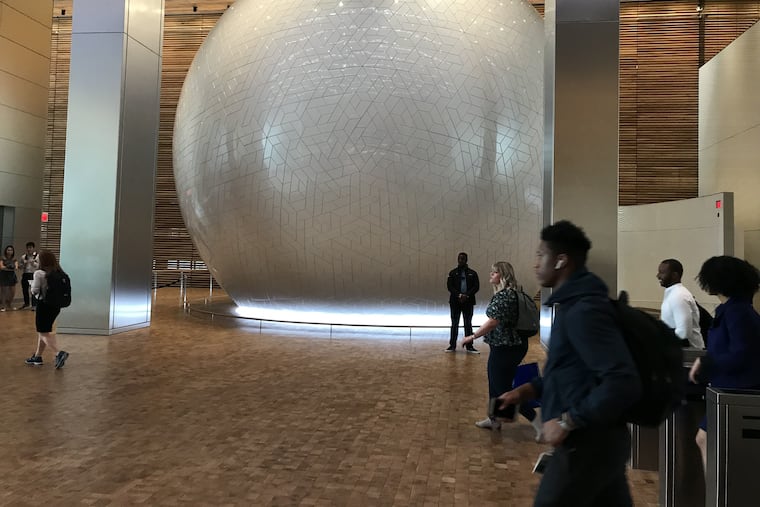That giant sphere in Comcast’s new tower? Watch a futuristic Spielberg short film there, free.
Comcast Corp. revealed it last week as a futuristic movie-viewing experience, something between virtual reality and a 3D planetarium. The company calls it the Universal Sphere after its Universal theme parks.

In a scene from the 1977 film Close Encounters of the Third Kind, the actor Richard Dreyfuss hurls garbage, dirt, bushes and bricks through his kitchen window to the horror of his wife, and then sculpts a big replica of Devil’s Tower in Wyoming. Dreyfuss’ character, in a hallucinatory fever, doesn’t even know — and neither did most movie-goers — what he was sculpting until later in the film about encounters between extraterrestrials and humans.
There is deja vu with that Steven Spielberg film and what looks like a big — some say creepy — golf ball on the second floor of the lobby of the new Comcast Corp. tower, across from the Vernick Coffee Bar.
Why is it there? Comcast officials wouldn’t say for months. But they revealed it last week.
The Universal Sphere is a cross between virtual reality and a planetarium, the creation of Comcast CEO Brian Roberts and Spielberg himself. Inside the spherical theater, Comcast shows a six- to seven-minute film about the power of ideas. It’s a futuristic and immersive experience. It’s free, but only about 25 people can watch at one time. Comcast has aweb site to get a ticket at a set time.
But a word of caution: Some viewers might need a small dosage of Dramamine for the vertigo when a sailing vessel falls off the edge of the Earth, or you are blasted to Earth from outer space. There’s a showing every 15 minutes Monday through Friday, 10 a.m. to 5 p.m., at the Comcast Technology Center at 18th and Arch Streets. Hours could be expanded to weekends.
Roberts calls the experience “like virtual reality without the glasses.” He said it may become the most iconic part of the new Comcast tower, the tallest skyscraper in Philadelphia. He is hoping for the same success as the company has had with its high-def video wall in the Comcast headquarters a block away, which was visited by about 270,000 people over the Christmas holiday.
“If you take all the parts of this company, there is only one place in the world where you would go and see that, and it would be Comcast,” Roberts said of the Universal Sphere.
So far, about 4,500 Comcast employees have cycled through the Universal Sphere. Among the Comcast subsidiaries that developed the attraction were Dreamworks Animation and the Universal theme parks. Spielberg — who directed Close Encounters — is credited as executive director. One of the producers was Chris DeFaria, part of the team with Spielberg on Ready Player One.
At one point in the film, you feel like you are traveling through a galaxy with star clusters shaped like the faces of great inventors and thinkers. You enter the next scene through Albert Einstein’s eye.
In another scene, you feel like you are swimming with a humpback whale.
The film, which revolves around the theme of ideas that shape the world, talks about projects that helped poor or sick people improve their lives. One short segment is on the Hippo Roller, developed in the early 1990s by South Africans Johan Jonker and Pettie Petzer, to transport water from wells without spills in Africa.
Another is on Veronika Scott, who developed a winter coat that could be transformed into a sleeping bag for the homeless in Detroit.
Yet another is researcher Carl H. June at the University of Pennsylvania, who developed the first personalized cell therapy for cancer to be sanctioned by the U.S. Food and Drug Administration.
And as with many good films, there is a surprise at the end.